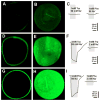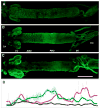Synergy and specificity of two Na+-aromatic amino acid symporters in the model alimentary canal of mosquito larvae
- PMID: 18456887
- PMCID: PMC3397476
- DOI: 10.1242/jeb.017244
Synergy and specificity of two Na+-aromatic amino acid symporters in the model alimentary canal of mosquito larvae
Abstract
The nutrient amino acid transporter (NAT) subfamily is the largest subdivision of the sodium neurotransmitter symporter family (SNF; also known as SLC6; HUGO). There are seven members of the NAT population in the African malaria mosquito Anopheles gambiae, two of which, AgNAT6 and AgNAT8, preferably transport indole- and phenyl-branched substrates, respectively. The relative expression and distribution of these aromatic NATs were examined with transporter-specific antibodies in Xenopus oocytes and mosquito larval alimentary canal, representing heterologous and tissue expression systems, respectively. NAT-specific aromatic-substrate-induced currents strongly corresponded with specific accumulation of both transporters in the plasma membrane of oocytes. Immunolabeling revealed elevated expressions of both transporters in specific regions of the larval alimentary canal, including salivary glands, cardia, gastric caeca, posterior midgut and Malpighian tubules. Differences in relative expression densities and spatial distribution of the transporters were prominent in virtually all of these regions, suggesting unique profiles of the aromatic amino acid absorption. For the first time reversal of the location of a transporter between apical and basal membranes was identified in posterior and anterior epithelial domains corresponding with secretory and absorptive epithelial functions, respectively. Both aromatic NATs formed putative homodimers in the larval gut whereas functional monomers were over-expressed heterologously in Xenopus oocytes. The results unequivocally suggest functional synergy between substrate-specific AgNAT6 and AgNAT8 in intracellular absorption of aromatic amino acids. More broadly, they suggest that the specific selectivity, regional expression and polarized membrane docking of NATs represent key adaptive traits shaping functional patterns of essential amino acid absorption in the metazoan alimentary canal and other tissues.
Figures






Similar articles
-
NHE(VNAT): an H+ V-ATPase electrically coupled to a Na+:nutrient amino acid transporter (NAT) forms an Na+/H+ exchanger (NHE).J Exp Biol. 2009 Feb;212(Pt 3):347-57. doi: 10.1242/jeb.026047. J Exp Biol. 2009. PMID: 19151209 Free PMC article. Review.
-
Cloning and functional expression of the first eukaryotic Na+-tryptophan symporter, AgNAT6.J Exp Biol. 2009 May;212(Pt 10):1559-67. doi: 10.1242/jeb.027383. J Exp Biol. 2009. PMID: 19411550 Free PMC article.
-
Molecular characterization of the first aromatic nutrient transporter from the sodium neurotransmitter symporter family.J Exp Biol. 2006 Aug;209(Pt 16):3183-98. doi: 10.1242/jeb.02374. J Exp Biol. 2006. PMID: 16888066
-
Cationic pathway of pH regulation in larvae of Anopheles gambiae.J Exp Biol. 2008 Mar;211(Pt 6):957-68. doi: 10.1242/jeb.012021. J Exp Biol. 2008. PMID: 18310121
-
Molecular basis of essential amino acid transport from studies of insect nutrient amino acid transporters of the SLC6 family (NAT-SLC6).J Insect Physiol. 2012 Apr;58(4):433-49. doi: 10.1016/j.jinsphys.2011.12.018. Epub 2012 Jan 2. J Insect Physiol. 2012. PMID: 22230793 Free PMC article. Review.
Cited by
-
Combined effect of Photorhabdus luminescens and Bacillus thuringiensis subsp. aizawai on Plutella xylostella.Appl Microbiol Biotechnol. 2022 Apr;106(8):2917-2926. doi: 10.1007/s00253-022-11905-2. Epub 2022 Apr 6. Appl Microbiol Biotechnol. 2022. PMID: 35384447
-
NHE(VNAT): an H+ V-ATPase electrically coupled to a Na+:nutrient amino acid transporter (NAT) forms an Na+/H+ exchanger (NHE).J Exp Biol. 2009 Feb;212(Pt 3):347-57. doi: 10.1242/jeb.026047. J Exp Biol. 2009. PMID: 19151209 Free PMC article. Review.
-
A novel eukaryotic Na+ methionine selective symporter is essential for mosquito development.Insect Biochem Mol Biol. 2013 Aug;43(8):755-67. doi: 10.1016/j.ibmb.2013.05.008. Epub 2013 Jun 6. Insect Biochem Mol Biol. 2013. PMID: 23748165 Free PMC article.
-
The invertebrate B(0) system transporter, D. melanogaster NAT1, has unique d-amino acid affinity and mediates gut and brain functions.Insect Biochem Mol Biol. 2008 Oct;38(10):923-31. doi: 10.1016/j.ibmb.2008.07.005. Epub 2008 Jul 30. Insect Biochem Mol Biol. 2008. PMID: 18718864 Free PMC article.
-
Characterization of a blood-meal-responsive proton-dependent amino acid transporter in the disease vector, Aedes aegypti.J Exp Biol. 2009 Oct;212(Pt 20):3263-71. doi: 10.1242/jeb.029553. J Exp Biol. 2009. PMID: 19801431 Free PMC article.
References
-
- Assis P, Boudko DY, Meleshkevitch EA, Phung E. Molecular expression and electrochemical analysis of phenylalanine-tyrosine transporter from Anopheles gambiae larvae. FASEB J. 2004;18:A1269.
-
- Bossi E, Soragna A, Miszner A, Giovannardi S, Frangione V, Peres A. Oligomeric structure of the neutral amino acid transporters KAAT1 and CAATCH1. Am J Physiol. 2007;292:C1379–C1387. - PubMed
-
- Boudko DY, Moroz LL, Linser PJ, Trimarchi JR, Smith PJS, Harvey WR. In situ analysis of pH gradients in mosquito larvae using noninvasive, self-referencing, pH-sensitive microelectrodes. J Exp Biol. 2001b;204:691–699. - PubMed
Publication types
MeSH terms
Substances
Grants and funding
LinkOut - more resources
Full Text Sources

